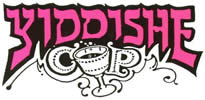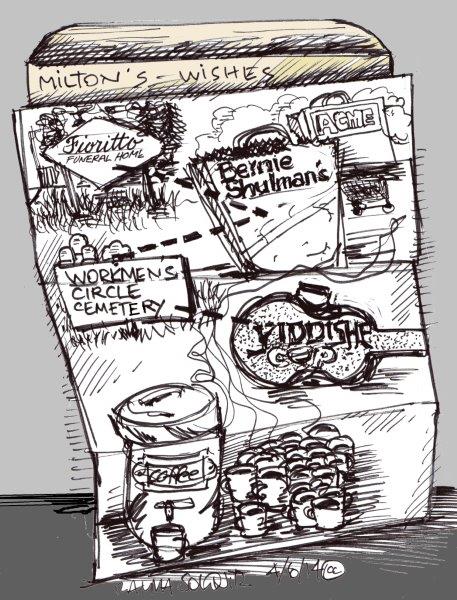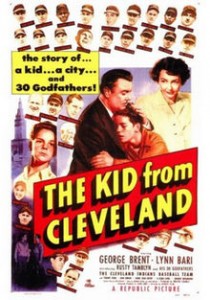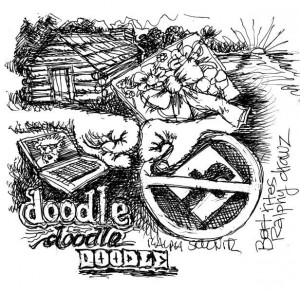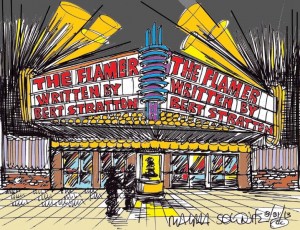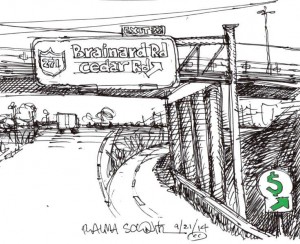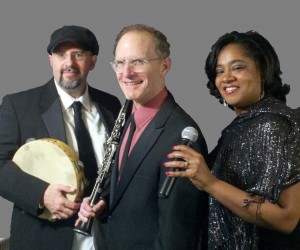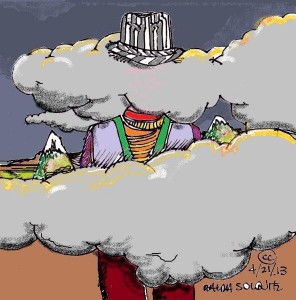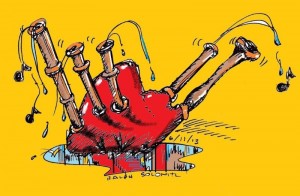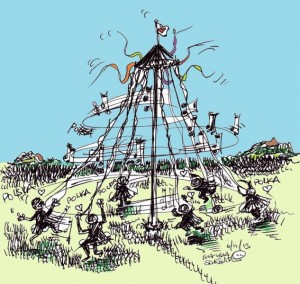Category — Cleveland, Full
WHATEVER HAPPENED TO PUTT PUTT?
My son Teddy had his birthday party at Putt-Putt on Northfield Road in 1990. I think that’s the last time I played Putt-Putt — official Putt-Putt. There are only 23 Putt-Putt courses in the United States.
There was a Chinese miniature golf course on Libby Road at Broadway Avenue. It had a Buddha that went up and down. My high school friends and I couldn’t get enough of that course.
Arnold Palmer Miniature Golf . . . Just had to say that.
I would like to live long enough to play Putt-Putt with my grandchildren. First, I need grandchildren. I want to stay healthy enough to bend down and pick up the ball. That’s the hardest part of miniature golf.
January 1, 2020 3 Comments
THE MICKEY KATZ NON-MOVIE
Eric Krasner wanted to make a movie about Mickey Katz, the Cleveland-born klezmer clarinetist and comedian. Eric came to Cleveland from Atlanta to look around. He wanted to see where Mickey was born, and where Mickey’s wife grew up, and where Mickey’s father’s tailor shop had been. I said, “I’m not a filmmaker — and I don’t want to tell you what to do — but if you want another opinion, I don’t think you should show every place Mickey took a shit.”
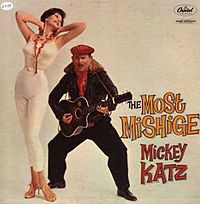
1959 album
Eric and I visited the Euclid Avenue Temple (now Liberty Hill Baptist Church), where Mickey was married in 1930. Eric filmed the men’s room and said, “This is where Mickey urinated after his wedding.” Eric asked me why Katz (1909-1985) wasn’t more acclaimed in Cleveland. For one thing, Mickey is not well-known here. He’s not Bob Feller or Superman, or Pekar.
Eric and I went to Glenville, an East Side neighborhood where Mickey spent his teenage years. We found the Glenville Hall of Fame but no Mickey plaque. At Katz’s birthplace, near East 51st and Woodland, Eric drew a sign, “Birthplace of Mickey Katz 1909,” and hung it on a fence and filmed the sign.
Eric announced on Facebook he is giving up on the Mickey Katz film. Mickey’s son Joel Grey has declined to participate in Eric’s film, and that’s a big neg. The movie is toyt.
July 17, 2019 3 Comments
STANDING IN LINE AT THE BMV
Do I get new plates or keep my 2003 Ohio bicentennial plates?
Whichever is easiest.
Entering the Bureau of Motor Vehicles, I had Harvey Pekar-level anxiety. But I lucked out; I was a plate transfer, not a new driver’s license, so I got to skip to the head of the line.
I had bought a Subaru Legacy and sold my Ford Fusion. Both cars are red, so nobody knows I have a new car. A disappointment. I wanted a blue car, but the Subaru Legacy doesn’t come in blue. I refuse to drive gray, silver, black or white. I miss the purple on the Plymouth Duster.
I was in and out of the BMV in 15 minutes. Can you beat that? I accidentally left one of my plates on the counter and a clerk ran out, yelled “sir” at me, and handed me the plate. I said to her, “At least I got you outside! Thanks.” It was 20 degrees and snowing. She said, “I don’t want to be outside.” The BMV. I miss Harvey Pekar.
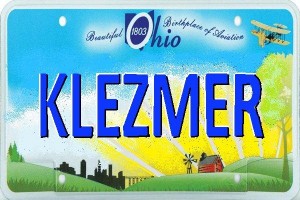
Not my plate, btw.
March 13, 2019 3 Comments
BIG NAMES
Howard Metzenbaum was a big name in my father’s generation. Metzenbaum made millions in parking lots, and eventually became a U.S. senator. My father and Metzenbaum were born the same year, 1917, in Cleveland. My dad didn’t know Metzenbaum but enjoyed following his career.
Metzenbaum, in his later years, owned a condo at Three Village, the holy of holies for upscale living on East Side Cleveland. The building went up in 1978 near Cedar Road at I-271. The Three Village condo development was wooded and secluded. My parents lived nearby, at the Mark IV apartments (now called the Hamptons). My parents liked brand-new housing; they weren’t keen on used. Everything had to be shiny and new, maybe because they grew up in poverty.
Across from the Mark IV was Acacia on the Green — a step up, rent- and prestige-wise, from the Mark IV. Next to Acacia was Sherri Park, a step down. Across from Sherri Park was Point East, a step up from Acacia but down from Three Village. These buildings all went up in the 1970s and were popular with my parents’ generation.
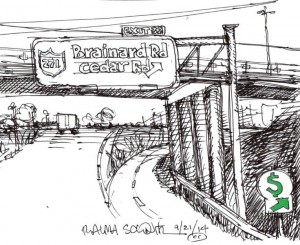
My parents never went inside Metzenbaum’s building. I did. I visited a rich friend who bought a condo in Three Village. Metzenbaum was long gone — dead as of 2008. The building’s buzzer directory read Maltz, Mandel, Ratner, Risman, Weinberger and Wuliger.
Maybe you have to be an old Cleveland Jew to appreciate that. If you’re not an old Cleveland Jew and have read this far, please explain why.
March 6, 2019 11 Comments
BACK WHEN ROOSEVELT WAS GOD
Jean Elsner, who died last week at 99, lived in her house on Stilmore Road in South Euclid for 61 years — until 2013, when she moved to a seniors building in Chicago to be near her oldest son. Jean’s father built the Stilmore house in 1951. In 2009, she was the oldest student at Cleveland State. She took courses for the fun of it.
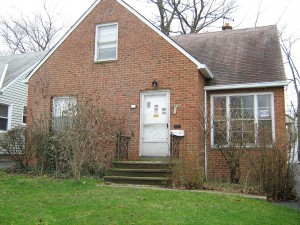
Jean’s house, 2011
Jean was very nice to my mother. When my mom became a widow, Jean didn’t bail on her like some friends of my mom did. And when my mother got Parkinson’s, Jean didn’t bail either. Jean called the building manager at my mother’s apartment because my mom was on the floor and couldn’t get up.
Jean and my mom went way back — to Kinsman Road. They shared a locker in seventh grade. When my mom moved to Cleveland from Mississippi in 1930, Jean welcomed her.
Jean knew me from day one. Jean said I was a fat baby.
I think I have a picture of Jean’s house with the Franklin Roosevelt picture in the den. In the 1940s she bought the picture for her parents, who “worshipped” Roosevelt, she said. “They thought Roosevelt was God. They had always been Socialist before then — voted for Debs — but they took a chance on Roosevelt in 1932.”
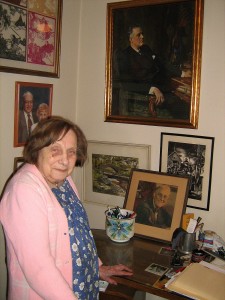
Jean and FDR, 2011
Jean wrote a letter to Eleanor Roosevelt in 1937, asking for help with the Homeowners Loan Corporation, which gave Jean’s dad a loan for a house. Jean had a permanent campaign sign in her front picture window: “Vote Democrat.”
Jean never drove. She took the bus. That was odd, at least for Cleveland. She allowed neighbors to park in her driveway.
Her breakfast was orange juice, hot chocolate and toast. She ate peanut butter and jelly and tea for lunch every day.
That’s some of what you need to know about Jean.
December 19, 2018 5 Comments
A FUNERAL WITH ALL
THE TRIMMINGS
May 15, 1990
Dear Children,
In 15 days I’ll be 71. As you know, I’m not religious, but I do like a good party. About my funeral: Use the gentile funeral home, Fioritto in Lyndhurst, to deliver my body to the Workmen’s Circle Cemetery. Just bury me. Invite some family and friends. No rabbi! I’ve never gone to synagogue, so don’t start with that now.
Pick a convenient Sunday afternoon to throw a memorial service at the Workmen’s Circle hall on Green Road. There is plenty room, a loudspeaker and a kitchen. Anybody who wants to speak, can speak — except Bernstein.
I want a nice sendoff: trays, Scotch, music, dancing, food, coffee, pastry, wine and cold beer. Whiskey too. Hire a klezmer band — Bert Stratton’s band. But remember, one hour of klezmer is enough.
Get the trays at Bernie Shulman’s at Cedar Center. They’re good and cheap, but you have to pick up the goods yourself. Get pastries from Acme supermarket at Mayfield near Green. Their pastries are excellent and much cheaper than the Jewish bakeries.
I want coffee — lots of coffee. The Workmen’s Circle can make it by the gallon. And plenty of soft drinks and wine — good wine. No Champagne. Hire kitchen help.
Mom will say I’m nuts. She can stay home if she wants! This is what I want.
Love,
Dad
—
Footnote: The author — a friend of my parents — died in 2006, 16 years after he wrote this letter. He lived to 87. He had a graveside service with no band and no food. No hard feelings.
I slightly “enhanced” his letter. I added except Bernstein to “Anybody can speak — except Bernstein,” and I added “One hour of klezmer is enough.” Couldn’t help myself. The letter is real.
October 17, 2018 3 Comments
GETTING LOUD
IN THE RESTAURANT
My friend Brian eats out often and is finicky. If his fries aren’t crispy, he sends them back. Brian gets annoyed by cheese. He doesn’t like sharp cheese. If there’s a short pour on the wine, he gets upset.
Brian works the room [the restaurant] like a celeb when he eats out — mostly at places where his buddies are. When we ate at Club Isabella, Brian pointed out the doctors and dentists in the room. Brian said, “That’s the guy who does the dental implants. He runs the full-page ad in the Plain Dealer.”
I said, “When I visit you in California [where Brian lives half the year], you’ve got to do better than docs who do dental implants.” Brian said he would take me to L.A. restaurants where I’ll have a greater than 50-50 chance of spotting celebrities.
Brian likes to say goyim loudly to elicit a reaction from nearby diners. (Nobody reacts. It’s too loud. Nobody hears him.)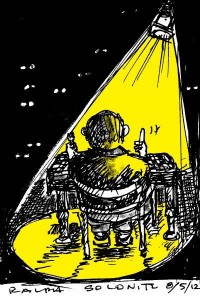
At Club Isabella, I suggested we out on the patio because it was quieter there, but Brian opted for the echo-chamber dining room. That night every happenin’ Jew in Cleveland was at Isabella’s. Brian worked the room: “How was Aspen, Sandy? . . . “How’s your tennis elbow, Jeff?”
I prefer Indian and Chinese restaurants, because they are usually quiet. I don’t like to suck cough drops and sip tea for weeks after nights out with Brian.
—
Brian is a pseudonym.
July 18, 2018 3 Comments
THE SCHVITZ
If you’re a Cleveland Jewish male and have never been to The Schvitz, you are a disgrace. Real Cleveland Jewish men will malign you, impugning your Jewish bona fides. The Schvitz is at East 116th Street and Luke Avenue, off Kinsman Road, in a lousy neighborhood. The Schvitz has no sign. The Schvitz’s official name is the Mt. Pleasant Russian-Turkish Baths, which nobody uses. Some people call it the Bathhouse. Some people call it the Temple of the Holy Steam. (Lawyer Harvey Kugelman does.) Most people call it The Schvitz. It has photos of Mussolini, Dayan and Patton on the walls. That’s it for decorations. (Plus a photo of Clint “Dirty Harry” Eastwood, reports Mike Madorsky.)
There are three acceptable responses to “Have you ever been to The Schvitz?”
a) I held my stag there.
b) I was there with my father.
c) My grandfather took me there.
The Big Five in Russian-Turkish–style schvitzes are in New York, Los Angeles, Detroit, Chicago and Cleveland. I got this list from Billy Buckholtz, the pleytse guy at the Cleveland schvitz. Billy’s grandfather was the original pleytse guy. Pleytse is the rubdown, traditionally done with a broom of soaked oak leaves. Billy uses a seaweed broom and horsehair brush.
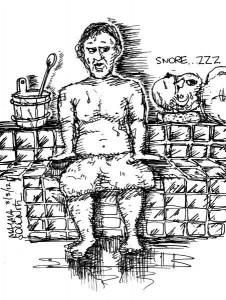
Cleveland’s schvitz isn’t coed. Most of the other schvitzes are. The Detroit schvitz even used to have an orgy night. The Cleveland schvitz never went coed, aside from a short experiment in the 1970s, because the neighborhood is so bad. Why encourage women to come to Kinsman?
In The Schvitz’s heyday, it catered to immigrant factory workers who dropped by after work “to get the creosote off their skin, knock down a few shots and get a pleytse,” Billy said. “The immigrants didn’t want to wait in line with their eight kids for the only bathtub at their house.” Billy told me all this at a Yiddishe Cup gig at an art gallery, not at The Schvitz.
I’m not crazy about steam. I get periodic Schvitz invitations from the Brothers in Perspiration, an ad-hoc group of Cleveland Heights Jews. The email subject-line reads: “Have a serious jones for the stench of sweat, mildew, steak, cigar, garlic?” That sounds good, except for the cigar, sweat, mildew and steam.
—
Rerun
November 1, 2017 3 Comments
RETURN OF THE MAGGIES
Maggies were linoleum salesmen/hustlers in Cleveland. “Maggie” is derived from Magnoleum, a flooring brand. Harvey Pekar wrote a comic strip about maggies in 1982. I didn’t hear the word maggies again until recently, when my cousin Danny Seiger expounded: “The maggies carried thick samples of linoleum that looked like Venetian marble. They sold nine-by-twelve sheets for fifteen dollars. Nobody had fifteen dollars back then, so the maggies took five bucks on installment, and came back with a roll of tissue-paper. They could carry it upstairs real easy. It weighed three pounds. The maggies laid the tissue-paper linoleum on your kitchen floor, collected the five bucks, and never came back.”
The maggies sold more than linoleum, Danny said. They sold ties at barbershops and socks at saloons. Each maggie had a territory and a product line.
I Googled “Maggies” after my cousin Danny left. Maggies, an Irish music group, popped up. Then I tried “Maggies + Pekar” . . .
Michigan State University Libraries,
Comic Art Collection.
“The Maggies: Oral History”/story by Harvey Pekar;
art by R. Crumb. 2 p. in American Splendor, no. 7 (1982).
I phoned Danny Seiger and read the Pekar story to him. I wanted to know if Turk’s deli — where the maggies hung out in Harvey’s comic — was the same place as Seiger’s deli. Danny said, “Turk’s was at One-hundred Seventeenth. We were at One-hundred Eighteenth.”
I said, “There were two delis right next to each other? How many delis were there in Cleveland?”
“There were seven on Kinsman, and twenty-eight in Cleveland in the 1930s,” Danny said.
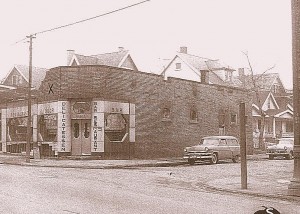
Seiger’s, 1958, (with fire damage)
–
A version of this first appeared here 8/4/10.
August 30, 2017 3 Comments
THE BILLYS
My parents often name-dropped Billys:
1.) Billy Rose. He put together the Aquacade show at the Great Lakes Exposition in 1936-7. The Aquacade was a theater-like pool. There was an orchestra and synchronized swimming. Johnny Weissmuller starred in it. Billy Rose took the show to the New York World’s Fair in 1939.
2.) Billy DeWolfe, a character actor. Billy De Wolfe occasionally ate at Seiger’s, my Great Uncle Itchy’s restaurant on Kinsman Road.
3.) Billy Weinberger, a Short Vincent Street restaurateur. He owned Kornman’s. Billy Weinberger moved to Las Vegas in 1966 and took over Caesar’s Palace. Billy was close with the Cleveland mobsters who started Vegas. My Uncle Al — not a gangster — once got discount hotel rates from Billy in Vegas.
I never name-dropped Billys to my kids. My parents took all the Billys.
—
A version of this post appeared here 10/19/11.
—
Funk a Deli (formerly known as Yiddishe Cup) plays at John Carroll U. 7 p.m tomorrow (Thurs., Aug. 10). On the lawn. Free ice cream. Featured guest artists: Shawn Fink, Jack Stratton, Rick Lawrence, Maury Epstein and David Krauss.
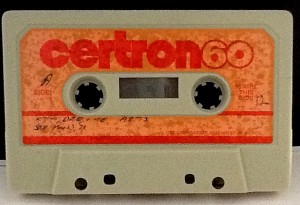
August 9, 2017 6 Comments
A LOVE SUPREME
The Jazz Temple was a former Packard showroom at Mayfield Road and Euclid Avenue. Coltrane and Dinah Washington 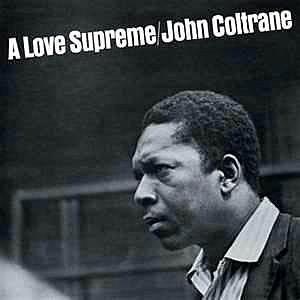 played there. The Jazz Temple was in business from 1960 to 1963. I passed the Jazz Temple weekly on my way to Sunday school at The Temple, the gold-domed Reform temple in University Circle.
played there. The Jazz Temple was in business from 1960 to 1963. I passed the Jazz Temple weekly on my way to Sunday school at The Temple, the gold-domed Reform temple in University Circle.
Rabbi Abba Hillel Silver was the head rabbi at The Temple. He once spoke at the United Nations, advocating for the founding of the State of Israel. Rabbi Silver’s son, Dan, was the assistant rabbi. Dan played football at Harvard and occasionally wrote for the Cleveland Edition.
At Sunday school, kids were mostly from Shaker Heights. One kid got a ride in a limo to temple. The driver wore a chauffeur’s cap. The limo wasn’t a Rolls; it was a Buick station wagon.
I couldn’t grasp how temple — the word — fit into the Jazz Temple. Was Jazz a religion too? Many years later, I met former beatniks who had actually gone to shows at the Jazz Temple.
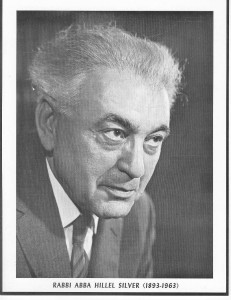 The Jazz Temple was blown up in 1963. Somebody didn’t like the club or the owner, Winston Willis, a controversial black businessman. At The Temple religious school, we students attended services every Sunday morning to hear Rabbi Silver. (Services were on Sunday, not Saturday, in the 1950s at Silver’s.) Rabbi Silver looked like God. Nowadays, at The Temple East in Beachwood, there is a Abba Hillel Silver memorial study. The rabbi’s desk is laid out like he just stepped out for lunch. He died in 1963, just six days after Kennedy got murdered.
The Jazz Temple was blown up in 1963. Somebody didn’t like the club or the owner, Winston Willis, a controversial black businessman. At The Temple religious school, we students attended services every Sunday morning to hear Rabbi Silver. (Services were on Sunday, not Saturday, in the 1950s at Silver’s.) Rabbi Silver looked like God. Nowadays, at The Temple East in Beachwood, there is a Abba Hillel Silver memorial study. The rabbi’s desk is laid out like he just stepped out for lunch. He died in 1963, just six days after Kennedy got murdered.
—
A slightly different version of this appeared 9/5/12. If you need baseball stuff, see my story at City Journal.
November 2, 2016 5 Comments
NO HARD FEELINGS,
SAYS COUNCILMAN POLENSEK
Nobody out-talks Cleveland Councilman Mike Polensek. He’s the quote machine. He once said, “I’m old-school Collinwood. You mess with me or my property, and I mess with you.” He called former councilman Jay Westbook a “weasel,” and former mayor Mike White a “son of a bitch, but our son of a bitch.”
Before Polensek was a councilman, he was a machinist at White Motors. I saw Polensek frequently in 1981 and 1982, when I was a reporter for the Sun Scoop Journal. Polensek ran for city council against Dave Trenton — a fellow incumbent Slovenian — in 1981. The city wards had been redrawn, and Polensek or Trenton was going to be out of a job. Trenton was “shanty Slovenian,” said my editor, another Slovenian. Trenton was slightly rougher-edged than Polensek. For instance, Trenton smoked a cigar in public.
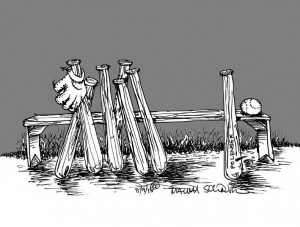 The editor endorsed Trenton, maybe because he and Trenton played softball together. The editor told me to survey the 14,000 registered voters in the ward. I talked to 75 people. Trenton received 32 votes in my poll. He had a plurality. The paper ran this headline: “Trenton called favorite in Ward 11 race.” And the endorsement stated: “As council’s majority leader, Trenton can serve the community from a position of strength . . . [He has] invaluable connections downtown.”
The editor endorsed Trenton, maybe because he and Trenton played softball together. The editor told me to survey the 14,000 registered voters in the ward. I talked to 75 people. Trenton received 32 votes in my poll. He had a plurality. The paper ran this headline: “Trenton called favorite in Ward 11 race.” And the endorsement stated: “As council’s majority leader, Trenton can serve the community from a position of strength . . . [He has] invaluable connections downtown.”
But Polensek, the underdog, won! When I walked into Polensek’s victory party at the Italian Cooperative Association Hall on St. Clair Avenue, a Polensek supporter announced, “Your paper endorsed Trenton!” Another man said, “You’re in the wrong place. You’re going to eat crow when you write up your shit. You’re one of the worst writers ever! What are you doing here?” A woman, somewhat calmer than the men, said, “I don’t think you’re going to find what you’re looking for here.”
They didn’t like me. (I was a curly-haired hippie Jew from the Heights. That didn’t help.) But Polensek liked me — liked me enough. He liked media people, period. He said, “Oh well, you’re here. Like I told your boss, I knew we’d win.” I said I would have voted for Polensek if I lived in Ward 11. Polensek wasn’t impressed. He said, “You’re disrespecting your boss.”
Polensek is still a councilman 35 years later. I ran into him a couple years ago and said, “You remember the ICA Hall, when some of your supporters wanted to kill me?”
He was foggy on it. I wasn’t. He said, “No hard feelings.”
February 24, 2016 5 Comments
HALF A JEWISH TOUR
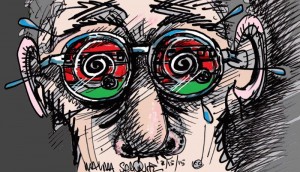 Exploring Jewish Cleveland
Exploring Jewish Cleveland
1850 – 1950
Tuesday, September 20 • 9:30 – 3:30
$30 JCC Members; $40 Non-members
Registration deadline: September 15
Code: 6316
Meet by the Mandel JCC front entrance
I bailed from the tour halfway through (at Liberty Hill Baptist Church, formerly Euclid Avenue Temple). I was on the bus for four hours, and the tour had three more hours to go, according to the guide. I can do local Jewish history but not seven hours. I missed Kinsman and Glenville. I caught the Central neighborhood portion. James A. Garfield (not Jewish) and Mickey Katz graduated from Central High.
I’d like two half-day tours of Jewish Cleveland.
—
Here’s “Homeboy,” about growing up in Cleveland and never leaving. From City Journal. L’shana tova.
September 9, 2015 1 Comment
CARMA
My son Ted parked his car at the Brookpark RTA lot and flew to Las Vegas. The RTA lot was cheaper than the airport lot. My son didn’t come back. I thought he was going on a vacation, but he got a job in Las Vegas and stayed for a while.
My son’s Ford Focus, a 2007, sat in the Brookpark lot for two months, until my wife, Alice, and I loaded our car with jumper cables and a generator air pump and drove to the RTA lot, which is next to Ford Engine Plant #1 and a couple strip bars.
I said to Alice, “Ted’s car is technically in Brook Park, not Cleveland. That’s good. If the car has been towed or stolen, we can deal with Brook Park red tape better than Cleveland red tape.”
But the car wasn’t towed or stolen. It was there. The doors were unlocked, and the tires were low, and there was a bottle of bourbon in the backseat.
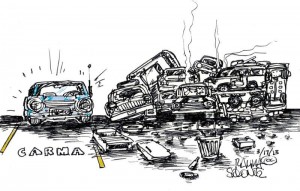
The next day I drove Ted’s car to the Lusty Wrench in Cleveland Heights. Sam Bell, the repair-shop owner, said, “The car is basically in good shape, with 89,000 miles. The battery will not make it, and as you know the side-view mirror is taped on. But the tape actually is not a bad solution. The rear tires are round, black and hold air.” The car was serviceable, he proclaimed.
What I want to know, Is Greater Cleveland really this safe? I need more data. Please park your car for two months at a Rapid stop and tell me.
—
This post first appeared at CoolCleveland.com 5/15/13.
—–
SIDE B
Here’s something new . . .
RECALCULATING
You dislike yourself for several very good reasons:
- You fist-bump too much. That is so childish. Shake hands!
- You have tiny cracks in your fingers that irritate others. Try fist-bumping.
- You are not 25, so act your age.
- Your sexuality is questionable.
- Cut back on the Facebook postings. Three a day is
too many. - Don’t be so jittery.
- Move to a log cabin. Or else go to an airport lounge with your laptop and iPhone, and live there for a week.
- Doodle more.
- Recalculating . . . ignore this.
May 13, 2015 3 Comments
MLACHAK, MLOTEK AND HRIBAR
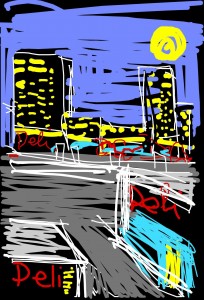 1. Norman Mlachak was a Cleveland Press reporter. I didn’t know him but knew of him. He grew up over a deli at E. 140th Street and Aspinwall Avenue. Every old-timer in Cleveland grew up over a deli, or near one. Nobody had a car, so there were a lot of delis. You bought food almost daily. Mlachak sometimes wrote nostalgic pieces for The Press. His neighborhood was Collinwood. He wrote about Fisher Body, Eaton Axle, Kuhlman Car Co. and the Collinwood Railroad Yards. He died in 1984.
1. Norman Mlachak was a Cleveland Press reporter. I didn’t know him but knew of him. He grew up over a deli at E. 140th Street and Aspinwall Avenue. Every old-timer in Cleveland grew up over a deli, or near one. Nobody had a car, so there were a lot of delis. You bought food almost daily. Mlachak sometimes wrote nostalgic pieces for The Press. His neighborhood was Collinwood. He wrote about Fisher Body, Eaton Axle, Kuhlman Car Co. and the Collinwood Railroad Yards. He died in 1984.
2. I went to high school with Helene Mlotek, who is probably related to Zalmen Mlotek, the New York klezmer macher. Aren’t all Jewish Mloteks related? Helene and I weren’t in any of the same classes.
3. Mary Lou Hribar grew up in and around Fritz’s Tavern, a polka hangout on E. 185th Street. Her father, Fritz, was inducted into the Cleveland Style Polka Hall of Fame, under the category “proprietors.” I once met Mary Lou at a Shaker Heights party and haven’t seen her since. Fritz died in 2001.
4. I was at Claudia Hlebcar’s wedding . . .
OK, enough. Thank you for your patience.
— Bert Ptacek
—
Irregular Passover Humor:
April 1, 2015 5 Comments
MY SHOW BIZ LUNCH
IN CLEVELAND
I had a show biz lunch at Corky & Lenny’s. The lunch was Hollywood-style, not Hollywood. Bert Dragin, the owner of a furniture store chain, was looking for a movie script. (This was in 1980. C&L’s was still at Cedar Center.) Dragin said to me, “I’ve got money. Everybody will talk to me in L.A. Right now I have something in the Best of the New York Erotic Film Festival.” He suggested I write a screenplay about a fire at a gay nightclub in Atlanta. Not my thing, sorry.
Dragin sold his Name Brand Furniture stores and moved to Hollywood to make movies. He produced Suburbia (1983), and directed Summer Camp Nightmare (1987) and Twice Dead (1988).
I wrote a screenplay, The Flamer, about a bar mitzvah party where several kids got burned to death by playing with sterno. [This paragraph is fiction. The rest is true.]
Dragin ran a tab at Corky & Lenny’s, which he probably paid monthly. He acted in his TV ads for the furniture store. “You heard of Erotic Salad?” he said. “It’s got a soft-X rating.”
“No.” That’s as close as I got to Hollywood.
March 4, 2015 6 Comments
MACHERS ON THE ROOF
Howard Metzenbaum was the big name in my father’s generation. Metzenbaum made millions in parking lots, and eventually became a U.S. senator. My father and Metzenbaum were born the same year, 1917, in Cleveland. My dad didn’t know Metzenbaum but enjoyed following his career.
Metzenbaum, in his later years, owned a condo at Three Village, the holy of holies for upscale living in Cleveland. The building went up in 1978 near Cedar Road at I-271. The Three Village condo development was wooded and secluded. My parents lived nearby, at the Mark IV apartments (now called the Hamptons). I don’t know why my mother went to apartment living from a colonial in South Euclid. She was a gardener, and then suddenly she was doing tomatoes in pots on her Mark IV balcony. My parents liked brand-new housing; they weren’t keen on used. Everything had to be shiny and new, maybe because they grew up in poverty.
Across from the Mark IV was Acacia on the Green — a step up, rent- and prestige-wise. Next to Acacia was Sherri Park, a step down. Across from Sherri Park was Point East, a step up from Acacia but down from Three Village. These buildings all went up in the 1970s and were popular with my parents’ generation.
My parents never went inside Metzenbaum’s building. I did. I visited a friend who bought a condo in Three Village. Metzenbaum was long gone — dead as of 2008 — and this was 2014. The building’s buzzer directory read Maltz, Mandel, Ratner, Risman, Weinberger and Wuliger (among others). Some of the condos were 7,500 square feet.
Maltz, Mandel, Ratner . . . Maybe you have to be an old Cleveland Jew to appreciate that. If you’re not an old Cleveland Jew, and have read this far, please explain.
Buzz. Come in.
—
The Klezmer Guy Trio performs at Nighttown, 7 p.m. Wed., Feb. 25. An evening of social commentary, plumbing tips and music. $10. 216-795-0550. Alan Douglass, piano and vocals. Tamar Gray, vocals. Klezmer, soul and standards. I’ll do prose blurts and play clarinet.
February 11, 2015 7 Comments
A FUNERAL WITH ALL
THE TRIMMINGS
The letter is from Milt — a friend of my parents — to his kids.
May 15, 1990
Dear Children,
In 15 days I’ll be 71.
As you know, I’m not religious, but I do like a good party.
About my funeral: Use the gentile funeral home, Fioritto in Lyndhurst, to deliver my body to the Workmen’s Circle Cemetery. Just bury me. Invite some family and friends. No rabbi! I’ve never gone to synagogue, so don’t start with that now.
Pick a convenient Sunday afternoon to throw a memorial service at the Workmen’s Circle hall on Green Road. There is plenty room, a loudspeaker, and a kitchen. Anybody who wants to speak, can speak. Except Bernstein.
I want a nice sendoff: trays, Scotch, music, dancing, food, coffee, pastry, wine and cold beer. Whiskey too. Hire a klezmer band — Bert Stratton’s band. (Bert is Julia and Toby’s son.) But remember, one hour of klezmer is enough.
Get the trays at Bernie Shulman’s at Cedar Center. They’re good and cheap, but you have to pick up the goods yourself. Get pastries from Acme supermarket at Mayfield near Green. Their pastries are excellent and much cheaper than the Jewish bakeries.
I want coffee, lots of coffee; the Workmen’s Circle can make it by the gallon. And plenty of soft drinks and wine — good wine. No Champagne. And hire kitchen help.
Mom will say I’m nuts. She can stay home if she wants! This is what I want.
Love,
Dad
—
Footnote: Milt died 16 years after he wrote the letter. He ate a lot and never exercised and lived to 87. He had a graveside service with no band and no food. No hard feelings, Milt. All mourners received a copy of Milt’s brisket recipe at the funeral.
I slightly “enhanced” the letter. I added Except Bernstein to “Anybody can speak. Except Bernstein.” And I added “One hour of klezmer is enough.” Couldn’t help it.
“Milt” is a pseudonym. If Milt’s children want his real name here, they’ll let me know.
June 18, 2014 9 Comments
AMERICAN GREETINGS
“Cleveland is a hard town. I came near committing suicide when I lived there.” — Robert Crumb, American Splendor intro, 1986.
Crumb worked for American Greetings. My dad, Toby, worked there too.
Toby was at American Greetings before Crumb. My dad worked with Morry Stone, who eventually became a vice chairman. My dad didn’t like working for anybody, including Morry, so Toby left in 1954.
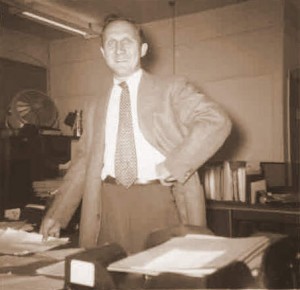
Toby Stratton, 37, at American Greetings, 1954
Everybody in Cleveland has worked at American Greetings, I think. Or tried to. I applied for a job at American Greetings in 1981.
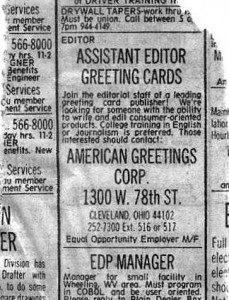
Plain Dealer, 1981
American Greetings had a Creative Building at West 78th Street. I didn’t even get called in for an interview. Maybe I wasn’t sick enough to write sick cards.
***
Robert Crumb again, 1996, Bob & Harv‘s Comics: “Cleveland is a city that has been ravaged by financiers and industrialists . . . its population abandoned to their fate, left to freeze their ass off, standing in the dirty winter slush, waiting for a bus that is a long time coming. Somehow they go on living.”
I haven’t lived anywhere else, so I can’t complain like Crumb. I went to college in Ann Arbor (which doesn’t count) and spent a few months in Bogota, Colombia, in my twenties.
Bogota was tougher than Cleveland. That, I can testify to. Bogota was rainy, gray, and headache-inducing from the high altitude. Cleveland was simply rainy, gray and slushy.
***
A pilot stood in a grassy field by the Bogota airport and said, “Tell your friends to throw their packs in back and we’ll be off.”
They weren’t my friends. They weren’t even Americans.
We climbed into the cargo section of the plane. “It smells like shit in here,” a Swiss girl said.
“This is Fish Airlines,” the pilot said. (Aeropesca.)
We landed in the Amazon a few hours later.
I ran into a college friend in the Amazon! I knew him from my freshman dorm. He said, “I scamp.” That meant he sold gems, coke, pot or counterfeit bills. “I’m going to reunite with my creators soon,” he said.
What?
“I’m going back to my parents.”
Adiós, amigo.
I tried to catch the ferry to Belem, Brazil. I waited several days in Leticia, Colombia, by the Amazon River dock, but the ferry didn’t arrive. I flew back to Bogota on the guppy/yuppie flight. (Guppies to Bogota, yuppies to the Amazon.)
In Bogota, I froze — even indoors. I wore two sweaters and socks-for-gloves in a small house I shared with a widow and her maid. I taught English at a nearby private junior high. For fun at night I read Cancer Ward . I also looked at photos of beauty queens from El Espacio and El Bogotano — the tabloids. My bedroom had doggy pictures on the wall, a toy cannon on the windowsill, and a crucifix over the bed.
For mental exercise I tried to reconstruct my high school schedule: first and second periods, PSSC Physics. What was third? What was PSSC? [Physical Science Study Committee.] I didn’t know many people in Bogie.
I heard Charlie Byrd play “Bogota” in Bogota. He was on a government-sponsored tour. Byrd en guitarra, con bajo y batería. (Byrd on guitar, with bass and drums.)
I went back to Cleveland after three months.
American Greetings. I couldn’t take Bogie. The major bookstore in Bogota was run by a Nazi, I thought. The owner was German, and I fabricated a fake bio, in my head, about him. I went to the Peace Corps office to borrow more paperbacks. I got Papillon, about a prisoner in Latin America.
I played blues harp for my English class. The kids loved it but the administration didn’t.
I had to leave. Bogie was un frío horrible (a freezing cold).
Crumb should write about Bogota. I want to hear his take on a real tough town.
—
Footnotes:
1. My Bogota adventure was in 1974.
2. I didn’t meet my college friend in the Amazon. I met him in Bogota. I remembered the encounter incorrectly. My friend straightened me out in Cleveland in 2013.
February 12, 2014 5 Comments
I BRAKE FOR ETHNICITY
1.
Yiddishe Cup has shared the stage with the Hungarian Scouts, Ukrainian Kashtan dancers, and Csardas, a Hungarian troupe. These groups draw fans to local festivals, and the dancers perform in difficult odd meters. Yiddishe Cup doesn’t draw many fans to these multicultural shows. The typical Jew doesn’t want to watch Ukrainians, Poles, or Hungarians dance.
At one festival, some of the folk dances had sappy English titles, like “My Little Cherry Tree” and “I Love You, Shepherd Boy.” I took the printed program home and looked up the real titles:
“Tylko We Lwowie” (Let’s Get Out of Lviv)
“Frogisic Sie Pani” (My Bagpipes are Soggy)
“Jaz Pa Ti” (Dad is Tipsy)
“Pytala Sie Pani” (Pierogis With Butter, Senator)
“Llactosi Nyasa Pilsenioya” (I Hate Milk and Like Beer)
“Jak Szybko Hund Chwile” (Jacko’s Chili Dog Is Outstanding)
“Nasza Jest, Noc Tylko” (Not Tonight, Not Tomorrow.)
2.
I bought a raffle ticket for the St. Mary’s Church (Collinwood) fundraiser, Catholic Order of Foresters, Court #1640.
I bought the ticket from Stan. Stan’s father was Stan too. Stan — my friend Stan – got married at St. William’s Church, not St. Stan’s. (St. Stan’s church is Polish. Stan is Slovenian.)
 Stan’s wedding reception was at the big Slovenian National Home on St. Clair Avenue at E. 65th Street. Stan hired his uncle’s polka band. At the wedding, we danced Slovenian-style polka — not the same as Polish-style polka. (If you don’t know the difference, please see Harvey Pekar’s “Polka Wars” American Splendor, issue #16.)
Stan’s wedding reception was at the big Slovenian National Home on St. Clair Avenue at E. 65th Street. Stan hired his uncle’s polka band. At the wedding, we danced Slovenian-style polka — not the same as Polish-style polka. (If you don’t know the difference, please see Harvey Pekar’s “Polka Wars” American Splendor, issue #16.)
Yiddishe Cup can play Slovenian! We’ve done Yankovic’s “Just Because” and “Blue Skirt Waltz,” and some charts from polka musician Joey Tomsick.
I won $20 in the St. Mary’s raffle. I haven’t seen the money yet.
Slovenians are tight with a buck. That’s their in-group reputation. Amongst themselves, Slovenians brag about their frugality, and they like to trash Lithuanians, who are even tighter. Stan told me all this.
The St. Mary’s Church raffle was three years ago. Stan, you owe me $23 — that’s $20 plus interest. Pay up, Stan. Any Stan.
September 25, 2013 6 Comments
